Hummingbirds are known for their ‘site fidelity.’ I was excited to learn of a Black-chinned Hummingbird nest in its 5th season. That meant she had made her journey safely to Mexico and back to Cottonwood, Arizona, returning to nest in the same spot 5 times! And I do mean the same exact spot – the base of the letter ‘O’ in the arch of the welcome sign over the front door. The hummingbird took them up on their offer of hospitality. How extraordinary!
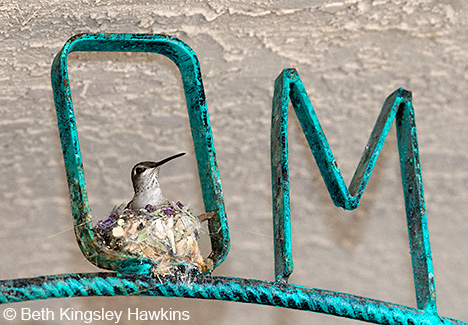
"There's No Place Like OM"
Click here to view the complete story of the "OM" with additional photos
This Black-chinned HummerMom chose to nest in a patio chandelier instead of a tree. When the wind blows, it gently rocks her sky cradle in the same way it would move a branch. Her choice of this unusual location provides the advantages of being out of the elements and affording a measure of protection from any predators.
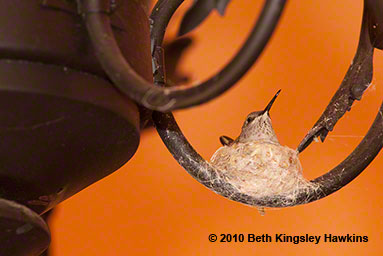
"Rock-a-bye Hummingbird"
I spent Mother’s Day photographing this little Black-chinned Hummingbird mother feeding her two chicks. She had discovered the relative safety of building her nest within a patio. She had returned from Mexico for the third time to renovate her original nest and raise her chicks—on the wings of a butterfly.

"On the Wings of a Butterfly"
A Black-chinned Hummingbird chose to crown this Indonesian carving with a nest. The color, shape, and placement of the nest provide remarkable camouflage. It was the second year she had returned to the same spot on the patio, refurbishing her nest with the successful outcome pictured here. This unusual site and sight were a delight to witness and photograph.
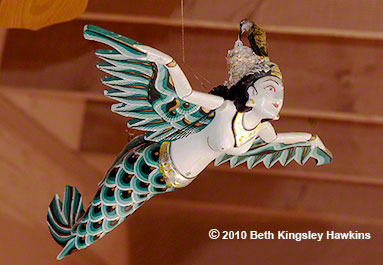
"Dragonlady"
This beautiful Southwestern Kokopelli wind chime hung on the patio for three years before attracting the attention of a Black-chinned Hummingbird looking for a sheltered place to build her nest. Imagine the homeowner’s excitement upon discovering her nesting in such a bizarre place, while incubating two tiny white eggs.
The HummerMom has used spider web to anchor the nest and hold it together. In the future the web will stretch, allowing the nest to expand and accommodate the growing chicks.
She has also used long strands of spider's silk for what she perceived as a need to stabilize the nest on this dancing figure.
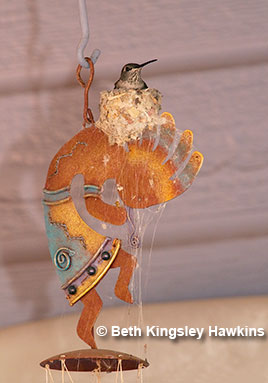
"The Dance of Life"
A dedicated Black-chinned HummerMom tends to her two very young chicks, who need to be fed several times an hour. She chose to build her nest under the sheltering leaves of an apricot tree. Even though their eyes haven't opened yet, Nature has provided a way for the nestlings to know when Mom is there to feed them. Two rows of tiny feathers on their back, called neossoptile down, move with the airflow of her wings, causing the chicks to open their beaks or gape.
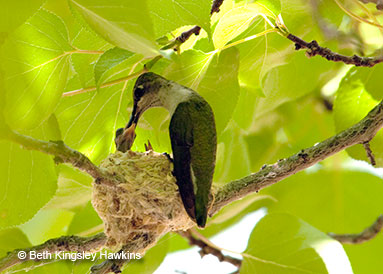
"Devotion"
First Documented Costa’s Nest in Sedona!
Inside a five-foot clematis plant, at the juncture of four tendrils, was the smallest nest I’d ever seen. Suddenly, the mother appeared. To my surprise, she had several purple feathers on her throat, identifying her as a Costa’s Hummingbird. Up until then, we believed that only Anna’s and Black-chinned Hummingbirds nested here in Sedona. Costa's are dry desert hummingbirds found predominantly in the southwest corner of Arizona. She is shown here sitting high in the nest above her two newly-hatched chicks to keep them warm between feedings.
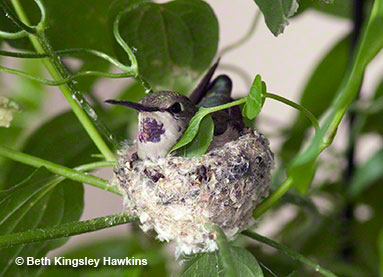
"Her Preciousness"
The male Costa's has a beard-like gorget that almost touches his wings. Like other male hummingbirds with iridescent feathers, he has control over when and to whom he shows his color. This is a big advantage when intimidating a rival or wooing a female. When he flashes his exquisite colors at us, it takes our breath away. Only the hummingbird can catch the sun and send it back to us.

"Desert Glow"
These two wombmates are all attention as Momma arrives with food. Their diet of bugs and nectar is not what we would savor, but it’s what they have needed for their growth. At this stage, they are actually heavier than their mother. The extra weight acts as Nature’s cushion while they learn to feed themselves. The chicklets are nearly ready to leave what is left of their tiny nest. Their diligent mother gets a star for raising such a successful brood.
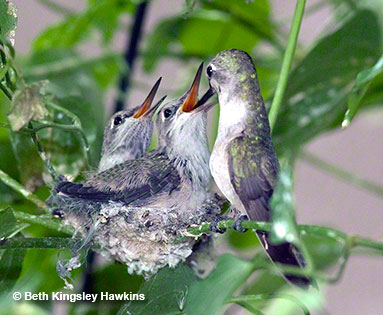
"Click 'n Clack"
This precious Anna’s Hummingbird is nesting in a white pine tree in the Village of Oak Creek. She has chosen the junction of three branches as
the best place to anchor her nest and has camouflaged it with lichen.
She will faithfully incubate her two tiny white eggs for 14 to 19 days.
The pine needles add a soft and beautiful matrix of color.

"Moment of Stillness"
In the next two days these two Anna’s Hummingbird chicks will fledge and leave their home of the past three weeks. At this stage of growth they barely fit in their tiny nest on the Arizona cypress branch. They are alert in response to hearing the approach of their mother, which means chow time. "Oh, we thought she'd never come!"

"Bookends"
The Anna’s Hummingbird is a year-round resident in Sedona,
Arizona. This species starts nesting earlier than any other
species in the United States. I observed a female taking nesting material in January and luckily found this nest in an Arizona
cypress tree in early March. The mother fed them a regurgitated
mixture of nectar and insects, which they appeared to find
delicious. The chicks fledged just one and two days after this
photo was taken.
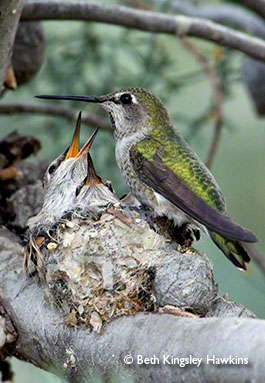
"Hummer Love"
The intense, iridescent color on this male Anna’s Hummingbird
serves to impress the female of the species—and we non-feathered creatures as well. In addition to having a spectacular
display, the male Anna’s can also sing! He does not migrate, so he is ours to enjoy year-round.
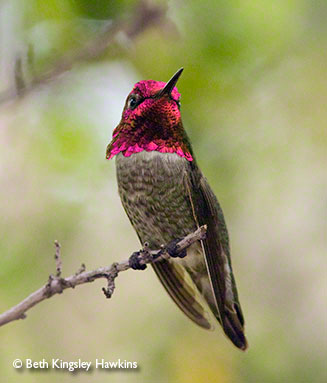
"Flash of Color"
The Anna's female can also be very creative in the placement of her nest. She chose to build it atop a fire sprinkler, over the front door of a golf resort clubhouse. Note how the nest camouflage matches the color of the wall. People walked in and out the front door and never looked up to see the new life that was happening there.
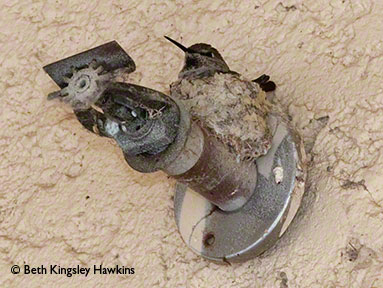
"Inventive"